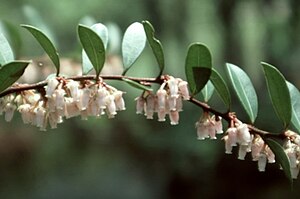Lyonia lucida
| Lyonia lucida | ||||||||||||
|---|---|---|---|---|---|---|---|---|---|---|---|---|

Lyonia lucida |
||||||||||||
| Systematics | ||||||||||||
|
||||||||||||
| Scientific name | ||||||||||||
| Lyonia lucida | ||||||||||||
| ( Lam. ) K. Koch |
Lyonia lucida is a species of the genus of Lyonien ( Lyonia ) within the family of Ericaceae (Ericaceae). It is common in the coastal plains of the southeastern United States from Virginia to Florida and Louisiana and occurs in Cuba . From the TNC is Lyonia lucida classified as "safely" ( "G5"). Common English names are fetterbush lyonia, hurrahbush, staggerbush; The common name "fetterbush" also refers to species of the grape heather genus( Leucothoe ) and the Pieris genus.
description
Vegetative characteristics
Lyonia lucida is an evergreen shrub with heights of 4 to 5 meters and the same width. It forms long rhizomes from which a colony can form. The branches have a scaly bark .
The leaves are arranged alternately. The leathery, simple leaf blade is egg-shaped, for example, with a length of up to 10.5 centimeters and a width of up to 5.5 centimeters.
Generative characteristics
The inflorescence is a fascicle . The hermaphroditic flowers are radial symmetry and five-fold with a double flower envelope . The corolla is usually pink, but can also be white or red.
If fertilization occurs, a capsule fruit is formed.
ecology
Lyonia lucida mostly reproduces vegetatively , but also produces seeds. It does not bloom in nutrient-poor soils and only reproduces vegetatively there through the rhizomes.
Site conditions
Lyonia lucida is a common species found in bushy bogs , humid savannas , coniferous swamps and shrubland. There are large populations in saw palmetto prairies. She is often in the Okefenokee Swamp . It also thrives in arid habitats, but is usually found in wetlands, including those that are temporarily flooded. It prefers acidic, water-saturated soils with a high humus content, for example in cypress swamps. It can survive in the shady undergrowth , but prefers sunny habitats.
The tree layers of these habitats include white cypress ( Chamaecyparis thyoides ), swamp magnolia ( Magnolia virginiana ), Persea borbonia , Gordonia lasianthus , tupelo trees ( Nyssa spec.) And pines ( Pinus spec.). The understory also consists of species such as deciduous grape heather ( Eubotrys racemosa ), American bilberry ( Vaccinium corymbosum ), Clethera alnifolia , Cyrilla racemiflora , Smilax laurifolia , Zenobia pulverulenta and oaks ( Quercus spec.).
Individual evidence
- ↑ a b c d e f g Timothy R. Van Deelen: Lyonia lucida . In: Fire Effects Information System . US Department of Agriculture, Forest Service, Rocky Mountain Research Station, Fire Sciences Laboratory. 1991. Retrieved May 10, 2019.
- ^ Lyonia lucida - (Lam.) K. Koch . The Nature Conservancy. Retrieved May 9, 2019.
- ↑ a b c d Bruce A. Sorrie, Alan S. Weakley, Gordon C. Tucker: Lyonia lucida . In: Flora of North America @ eFloras.org . Retrieved May 10, 2019.

